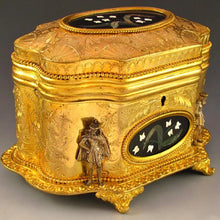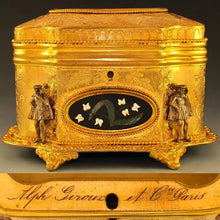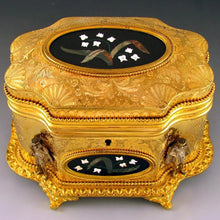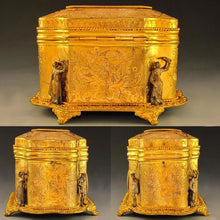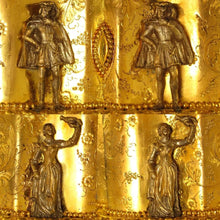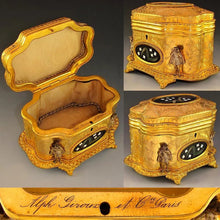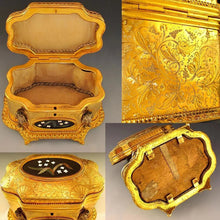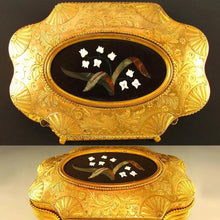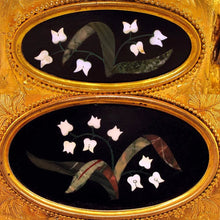
An exceptionally fine antique 19th Century French gilt bronze ormolu jewelry casket by Alphonse Giroux, a cabinetmaker of the Napoleon III era whose works are highly revered as the finest in Paris during this time period, of a caliber as Tahan and Vervelle. This superb jewelry casket features two oval shaped pietra dura plaques and adorned with four figural corner statuettes. The serpentine shaped body is elaborately festooned in intricate engraved scrolling flowers, the two pietra dura plaques framed in minute beading and the lid embellished even further by engraved shells together with more delightful floral motifs. Four theatrical figures in costuming of a Renaissance or Elizabethan theme decorate each corner, residing in a alcove within the serpentine formation and atop a gadrooned border. Two ladies have an arm outstretched to great a charming dove and two gentleman stand in thoughtful contemplation all the while having a dagger at the belt. The casket has a lock but is lacking a key. The lid opens to reveal a cream silk lined interior and engraved on the lock plate with Alph. Giroux et Cie, Paris. The box rests on four ornate stylized feet. In good condition with some wear to the gilding as well as staining to the interior fabric lining commensurate with age. Such excellent quality exhibited here in this ornately decorated jewelry box. Measures 6 1/2" length x 4 7/8" wide (including the feet) x 4 3/8" tall.
Founded in 1799 by Simon Alphonse Giroux (1775-1848) Parisian cabinetmaker and official restorer for Notre Dame, the firm of "Maison Alphonse Giroux" also known as "Giroux & Cie" was located at 7 rue du coq Saint-Honoré in Paris. Specializing in producing fine objects d'art and exquisite furniture for a list of wealthy clientele and patronized by members of the French Royal Family, including Louis XVIII, Charles X, Henri V and especially Napoleon III and Empress Eugénie. Giroux was also a relative of Louis Jacques Mandé Daguerre, the French artist and scientist who invented the daguerreotype. Giroux contributed to Daguerre's success by making the first production of the camera, "La Daguerrotype," in fine walnut. In 1838, the business was taken over by his eldest son, Alphonse Gustave Giroux. Under his guidance and innovative planning, the business grew to become one of the first and most prestigious department stores in Paris, while continuing to take important commissions for custom work. The firm received a silver medal at the 1839 Exposition des l'Industrie Francaise and produced pieces for the World Exposition of 1855.








